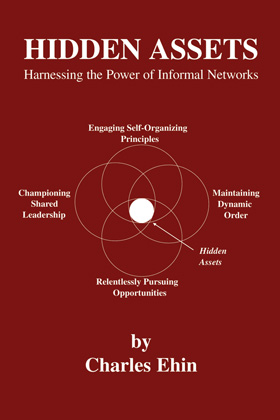Hidden Assets: Harnessing the Power of Informal Networks
by Charles (“Kalev”) Ehin, PhD
Publisher: Springer
Find it on AmazonThe Salt Lake Tribune, Business Insight, Monday September 6, 2004 by Lisa Carricaburu.
Charles Ehin, author of Hidden Assets: Harnessing the Power of Informal Networks, Westminster College management professor emeritus and former Dean of the Gore School of Business
What are the hidden assets in the workplace to which the title of your book refers?
The “hidden assets” that I describe and examine in the book are the very dynamic and messy yet “invisible” behind the scenes day-to-day activities of organizations where ironically more than seventy percent of all work is accomplished in the first place. These unseen activities take place among and between all sorts of informal social networks that are not and cannot be controlled by management in the traditional sense. They are also not found on any financial statements. All one has to do is sit back and visualize how things actually get done at one’s place of work. They certainly are not achieved by strictly following the official procedures and directives to the letter. Thus, most of the primary assets in any organization (for profit or non-profit) are “hidden” and can only be “harnessed” by an organizational context that promotes and supports “voluntary cooperation.” Essentially, the book is more about life in general than just management.
How do these assets relate to business effectiveness?
Certainly, businesses have become less bureaucratic in the last few decades. However, the efforts made to “empower” people have, to say the least, been dismal. The generation of knowledge is particularly dependent on voluntary collaboration and self-determination. So, what I have done is to pinpoint the dynamic relationships of three primary factors that are the foundation of informal social networks where intellectual capital is actually formulated. These interdependent factors are self-organization (free flowing unmanageable dynamic social relationships), social capital (informal support networks that individuals and groups develop naturally over time), and tacit knowledge (the unspecified knowledge individuals and groups accrue through experience and working together with more knowledgeable individuals over a lifetime). With an array of interrelated models, I demonstrate how an organizational context, I call a shared-access system, can enhance the dynamics of the “triad” and harness the ideas of knowledge professionals for the continuous development of new products and services.
Describe a “shared access” system as defined in your book. What does this suggest about traditional leadership within an organization?
Organizations wanting to tap into their hidden assets need to move from hierarchical configurations to increasingly voluntary collaborative arrangements I have defined as “shared-access systems.” This involves inviting self-motivated people to join the enterprise, supporting individual and team autonomy, developing a shared cultural identity, embracing a challenging but agreed upon vision, and practicing “no bossing” or shared leadership. I define shared leadership as, “Helping others to initiate or participate in worthwhile activities that they are either not aware of or are hesitant to take action on their own, which would benefit everyone involved.” Clearly, true leadership has little to do with organizational position power. Instead, shared leadership is emergent and dependent on specific circumstances. Shared-access enterprises by design are self-managing arrangements founded on the dynamic power of informal social networks because new ideas cannot be forced out of people. Shared-access systems are by no means perfect but given the choice, most humans would prefer to work in such environments.

